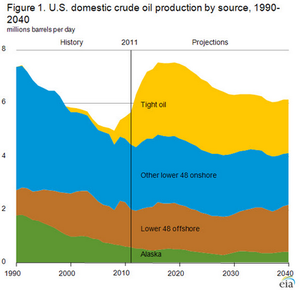Energy independenceU.S. oil production exceeds imports for first time in two decades
The United States is well on its way to energy independence, with the Obama administration announcing Wednesday that domestic oil production surpassed imports for the first time in nearly two decades. A report by the U.S. Energy Information Administration (EIA) offers proof that the United States has managed both to increase domestic oil and gas drilling and reduce the nation’s carbon emissions, which have dropped to a 20-year low. Since 2008, U.S. crude oil output has increased 50 percent, while imports have fallen about 20 percent.

History and forecast of domestic U.S. oil production 1990 - 2040 // Source: commons.wikimedia.org
The United States is well on its way to energy independence, with the Obama administration announcing Wednesday that domestic oil production surpassed imports for the first time in nearly two decades.
A report by the U.S. Energy Information Administration (EIA) offers proof that the United States has managed both to increase domestic oil and gas drilling and reduce the nation’s carbon emissions, which have dropped to a 20-year low. The Financial Times reports that under Obama – since 2008 – U.S. crude oil output has increased 50 percent, while imports have fallen about 20 percent.
The rise and perfection of fracking, a drilling technique which has transformed the American energy landscape, have made a significant contribution to a robust increase in domestic oil and gas production, leading to an American energy production renaissance.
The shift also has led directly to the drop in carbon emissions as utilities have turned to cheaper natural gas than coal.
The White House seized on Wednesday’s good news to take at least some credit.
“This is a significant milestone, a reflection of the president’s ‘all-of-the-above’ approach to energy production as well as his commitment to reducing carbon emissions,” White House press secretary Jay Carney told reporters. “It’s rather remarkable, if you look at the trajectory over the last two decades, that we are now importing less foreign oil than we are producing here at home.”
The United States averaged 7.7 million barrels of crude oil production per day in October, according to EIA figures. This is the highest number since 1995, and the agency said it is expected to rise to an average of about 8.5 million barrels per day in 2014.
In 2010, the second year of Obama’s presidency, the United States averaged 5.4 million barrels per day.
The production of natural gas has significantly increased as well, leading analysts to conclude that the United States will become virtually energy independent within a decade if present trends continue.
The impressive increase in oil and gas production has been accompanied by a no less impressive reduction in carbon emissions.
The EIA said that last year, American carbon emissions fell by 3.8 percent, reaching their lowest level in two decades.
Since 2007, emissions have dropped by 12 percent.
David Goldston, government affairs director with the Natural Resources Defense Council, a leading environmental organization, said, “I think the administration and the president have contributed to that.”
He pointed to the administration’s automobile fuel standards as a key reason for the drop in emissions, and to the fact that utilities were moving from coal to natural gas.
The growth in domestic oil production is beneficial not only for the U.S. security position in the world – domestically, it has also transformed the country’s refining and petrochemical sectors. The export of crude oil from the United States is severely restricted, but more refined products, such as diesel, can be more easily exported.
